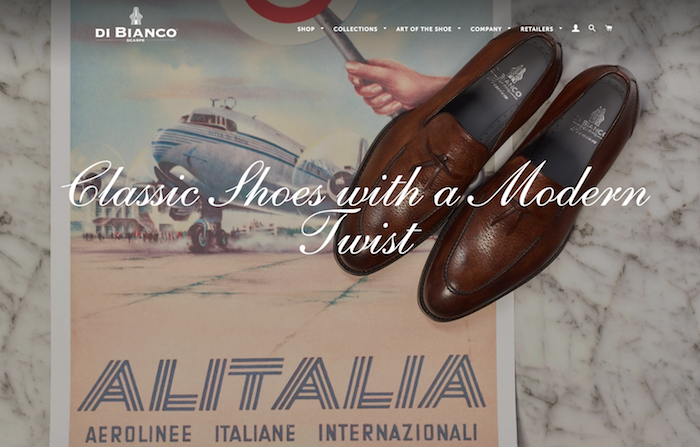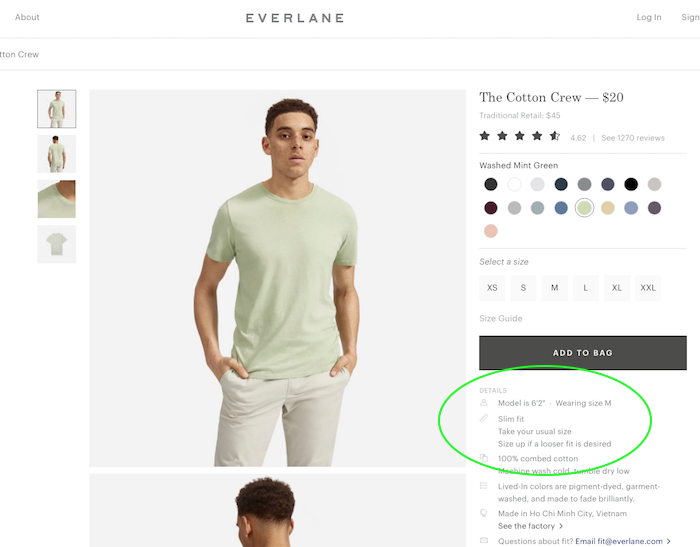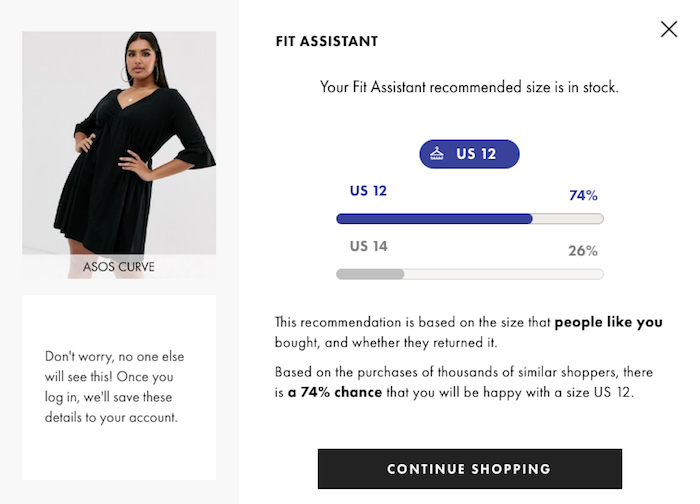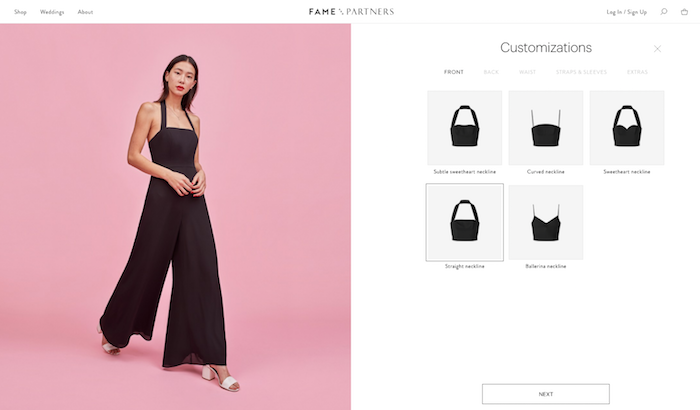4 Ecommerce Solutions That Lead to Great Buying Experiences for Apparel Brands

When it comes to selling products online, there are several issues specific to fashion brands. The challenges of apparel ecommerce include things like communicating sizing and helping customers find the right fit. If a retailer doesn’t get these things right, they may have to deal with excessive product returns. Over time, a lot of returned clothes can add to the long-standing issues of unused inventory and textile waste in fashion.
1) Solving for Ecommerce Sizing: Show Apparel to Scale

First and foremost, as we talk about common ecommerce issues for wearable brands, we’re going to distinguish between sizing and fit. Sizing is about showing customers how a garment fits on people in general. Fit is how that garment will fit on a specific person’s body. Both size and fit are important, and we’ll start here with size.
To communicate size online, it’s crucial to show your products to scale. So, for example, if you show a model wearing a dress on a product page on your site, be sure to share the model’s own size. In fact, the more information that you can give about the model’s size, the better.
One of our favorite examples of great sizing information is Everlane. In the case of their Cotton Crew t-shirt, they show the shirt on a male model. Then, in the product information, they share that the model is 6’2” and wearing a medium in the shirt. They add that the shirt runs in a “slim fit.” And if you want the shirt to fit like it does on the model, you should order your usual size. But if you want it to be looser, then order a size up. With just a few key phrases, they have communicated how this shirt is going to fit. This gives shoppers more confidence to buy.
Another online clothing retailer, Good American, takes it a step further. Not only do they tell you the model’s height and size, they let you select which model you want to view throughout your site browsing. For instance, in the denim section, you can view every style of jeans on one of three models. The models are all 5’9” tall, but they range in sizes. One is a 0, the next is a size 8, and the third is a size 16. This a super useful way to show how clothing will look on different body sizes.
2) Solving for Ecommerce Fit: Custom Apparel Fit Tools

Once someone decides they like a garment on your site, then they want to know how it will fit on their specific body. The sizing help we highlighted above will help a lot. Next, in order to finalize the sale, it best to confirm the customer’s unique sizing with your products.
We’ve written previously about ecommerce tools to help customers find the perfect fit. The key point is tools are coming out all the time to help retailers assist their customers in finding the right fit for their clothing. Some of these tools ask people to input data, such as their body measurements. Others ask customers to share the measurements of their favorite shirt (or whatever they are shopping for) that’s already in their closet.
Keep in mind that for a while, we had the Zozosuit. This was a program where customers put on a skintight suit, covered in sensors, and used an iPhone app to measure their body. ZoZo, the Japanese company behind the Zozosuit, initially gave away the suit for free to customers. In fact, they sent out nearly a million suits. But, in the end, customers did not adopt the technology. Unfortunately, this became a costly experiment about how willing shoppers are to work to get the perfect fit. Some reviewers also felt the Zozosuit involved too much personal information, and it caused trust issues with the Zozo brand.
Thus, in planning the ecommerce fit feature for your site, keep it as simple as you can. Asos is a great example of a company that doesn’t ask too much in giving customers a personalized fit recommendation. All you need to do is enter in a few pieces of information – things like height, size, and fit preference i.e. looser or tighter – and the site suggests the best fit for you. It also adds in a percentage, such as “there’s an 74% likelihood you’ll like the size 12.”
3) Tackling the Inventory Issue: Partners like Stitch Labs or an ERP

Social media has had a huge impact on fashion and apparel brands in the past decade. As a result, it’s one of the main verticals that people expect to buy digitally, especially on mobile phones. In fact, earlier this year, Mobile Marketer reported that 76% of large retailer traffic comes from mobile devices.
The mobile channel adds to the more traditional outlets for fashion brands, whether that’s selling from their own physical stores or wholesale to a department store. Today wearable brands face a lot of pressure to sell via omnichannel. And one of the greatest challenges to omnichannel selling is managing inventory.
Thankfully, a lot of smart people with deep experience in retail are working to solve the issue of ecommerce inventory management. For example, take a look at Stitch Labs. Stitch’s main feature is their inventory management system. This system allows a retail operations team to constantly monitor sales via all channels. It provides a dashboard for the whole operations team to understand how all products are performing in real-time.
Another way to solve the inventory challenge – and integrate more of your company’s backend processes together – is to implement an ERP (enterprise resource) program into your ecommerce site. Not only can ERPs manage inventory, but they can also handle things like broader customer data, employee payroll data, and more. For more information about ERPs for fashion and apparel ecommerce companies, check out these 6 Things to Know about ERP Integrations.
4) Solving for Textile Waste: All of the Above + New Innovation

Historically-speaking, one of apparel retailers’ biggest problems has been the issue of waste. For instance, in 2015 alone, discarded clothing, shoes, etc. composed the majority of over 10 million tons of textile waste in American landfills.
The good news: technology is creating a smarter supply chain. Take the inventory issue, for example. Indeed, it’s more profitable to have better control over your inventory – and it’s likely to generate less waste. If a product isn’t selling well, you can get this information sooner than before. As a result, you have the ability to quickly stop (or change) the production of something that isn’t selling well. Accurate sizing information also helps reduce waste.
Lastly, it’s exciting to see how innovative clothing retailers are solving the problem of textile waste. For example, Fame and Partners creates made-to-order clothing. They offer a collection of clothing in the traditional sense. But where they depart from business as usual is every garment is made-to-order. Customers can customize aspects of the clothing. They can change a crew neck to a v-neck, shorten or lengthen hemlines, or alter garments in bigger ways. Once the order is placed, then Fame and Partners produces it.
After customers receive their order, if they need to further tailor their purchase, Fame and Partners offer a $50 credit towards alterations. This helps ensure that the buyer won’t return the item. But, if they must send it back, Fame and Partners charge a $35 “zero-waste fee” as a way to discourage returns.
Ecommerce can be challenging for wearable brands, but it can also be super beneficial. Technology offers solutions to several long-standing issues for the fashion industry, including sizing, fit, inventory management, and textile waste. With new innovations coming out all the time, the future is bright for apparel ecommerce.
